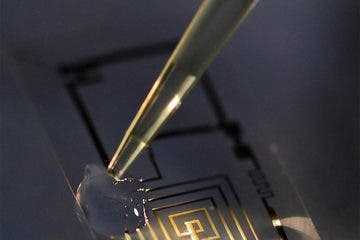Dissolvable electronic materials could be extremely useful in medical procedures and environmentally friendly gadgets – and they’re almost here.
Dissolving electronics
A team of researchers has created flexible electronic circuits which dissolve in water or inside your own body; the project is led by John Rogers, a materials scientist at the University of Illinois at Urbana-Champaign, and Fiorenzo Omenetto, a biomedical engineer at Tufts University in Medford, Massachusetts. Of course, the first use would be to create devices which just dissolve after they have served their purpose, thus enabling surgical implants which no longer have to be removed and minimizing the environmental impact.
In order to demonstrate the technique, the team developed a few great gadgets: a thermal patch that prevents infection after a surgical site is closed up, an imaging system that monitors tissue health from within a mouse and solar cells and strain and temperature sensors. The team now claims, that after several years of work, they are able to make pretty much any type of dissolving high-performance electronic or optical device.
The whole project started in 2009, when Rogers’ expertise on flexible silicon electronics met Omenetto’s tough, biocompatible silk. The silk itself has a fascinating story, being made from processed proteins from silkworm cocoons which make thin sheets that conform and stick to tissues, such as the surface of the brain. By changing the processing conditions, Omenetto can then control how long it takes the silk to break down when wet. After the conditions were perfectly controlled, Rogers’ silicon integrated circuits together with light-emitting diodes and other, more complex electronic devices were applied to the silk. Since then, they’ve demonstrated numerous applications, including brain interfaces that take very sensitive electrical measurements as well as a number of electronic devices that do absolutely no harm when dissolved. Their research is now published in Science.
Fully disintegrated

Biodegradable electronics could save lives, starting today
Their research is now fulfilled because they managed to show that every part of the system can disintegrate, regardless of its nature, application and environment. The key here was to replace typically used metals such as copper and iron with magnesium; magnesium is also conductive, but also extremely reactive to water – which is exactly why it isn’t used in electronics. For the team’s purpose however, it was perfect. They constructed circuits and antennas and wires which can be powered from outside the body.
The other, decisive ‘Eureka!’ moment for the team was when they figured out what role silicone can play here. Silicone typically takes 1000 years to dissolve in water, so it seemed little could be done here. But again, science found a way. Silicone membranes dissolve at about 4.5 nanometers a day, so by creating extremely thin (like 100 nanometers) membranes and tuning them to the properties of the silk, this problem was solved as well.
This is extremely important research, one which easily tops other biodegradable electronics research which work with organic materials. While organic materials are indeed easier to work with in such an environment and are easily degradable, the electrical and optical properties aren’t as good, and they are not compatible with the manufacturing techniques currently used by the semiconductor industry. This mixing of silicone, magnesium and processed silk is absolutely spot-on for this type of development.
Moving on to production
So unlike many extremely exciting research which will only be available in years, this one can be produced NOW. All the problems are worked out, all that’s left to do is figure out what to build.
“What diseases are we going to treat?” asks Christopher Bettinger, a materials scientist at Carnegie Mellon University in Pittsburgh, Pennsylvania.
With new funding from the US Defense Advanced Research Projects Agency in Arlington, Virginia, the group is now working with a manufacturer to scale up production of the silicon–silk components. Most likely, medical implants which don’t need to be as sophisticated as microchips will probably produced first, and will solve numerous problems, especially after surgery, saving lives and easing suffering. After that… the sky is the limit.









